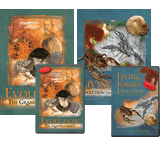Polar Bear Quiz Answers
Find answers to the polar bear quiz.
Male polar bears sleep in dens, or hibernate, during the winter.
False! In October or November, pregnant females enter their dens. Male polar bears continue to roam, looking for food.
The Arctic fox has a beautiful white coat all year long, great for hiding in the snow.
False! The Arctic fox sheds its white coat for a brown one as summer approaches. This insures that he will continue to be camouflaged . . . or more easily hidden outside. In September or October he again begins to get his white coat . . . ready again for hiding in the snow.
Both male and female caribou have beautiful, permanent antlers used for fighting.
False! Although both male and female caribou do have antlers, they lose their antlers once a year and grow new ones. These antlers are used for fighting and protection.
The sounds of beluga whales can be heard from miles away.
True! Beluga whales are sometimes called “sea canaries”. They “talk” more than any other whale. There have been eleven different beluga sounds documented. They grunt, they click, they whistle, they squeak. On a calm day they can be heard a long way off.
Over half of the 450+ species of sharks inhabit the frozen Arctic.
False! Most sharks live in the warm, tropical waters of the south. There are 465 shark species in the world. Of these, only eight have ever been seen in the frigid Arctic. In fact, during the winter, the Greenland sharks live in the deep of the sea way beyond the depth of other sharks. They go down 1300–2000 ft. or 400–600 meters.
Both male and female walruses have white tusks used for many things, including gathering food.
True! The Walrus babies begin to grow tusks at about 4 months old. The males have larger tusks but the female also grows them. They drag their tusks on the bottom of the sea to find their food. The tusks come in handy for lots of other things, too, including fighting and protection.
Lemmings hibernate into their snow tunnels during the cold winter months.
False! The lemmings do not hibernate. They stay very active in their snow tunnels where they find food. Food that they may have stored away in order to be prepared for the winter.
The snowy owl, like other owls, is nocturnal, and hunts primarily at night.
False! These owls are highly “diurnal” (are awake, hunt and eat during the day). They eat a lot of the Arctic rodent type animal, lemmings. They like to sit very still and wait very quietly until their “dinner” comes by. They can fly quickly and quietly, close to the ground and pick their prey up off the ground, off the water, or right out of the air.
The penguin is one animal you will not see at the North Pole.
True! Penguins are found at the very opposite end of the earth. They live in the Southern Hemisphere, and the Emperor Penguin even nests on Antarctica. They are not found in the Arctic.
The Polar Bear
Each issue of Answers magazine includes an outstanding Kids Answers section that highlights the wonders of God’s creation with kid-friendly information, images and games. This edition has great kid-friendly information about polar bears, a “search-and find” poster featuring hidden arctic animals and more!
Browse Kids IssueRecommended Resources
- © 2025 Answers in Genesis
- Privacy Policy
- Contact
- About


